Septoria, Alternaria, Fusarium, Nematodes!
No, they’re not magic spells, but they do make growing your tomatoes what we'll affectionately call... an adventure! This garden favorite is quite vulnerable to a number of fungi, bacteria and insects but there are many things YOU can do to help treat and protect your plants.
Please note many on this list may impact other vegetables but, for our purposes, the focus will be on your tomato harvest.
Let's begin with blight....
Early blight
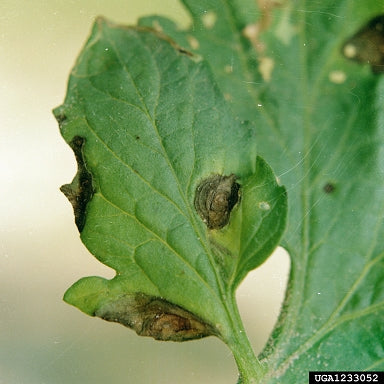
Also known as Alternaria solani, will first show signs at the base: circular brown spots that may develop concentric rings. Sometimes a yellow halo will form. Despite the name, it often occurs at the end of the tomato growing season. If it spreads and destroys the leaves, it will leave your fruit susceptible to sunscald. If it reaches the fruit, it will bruise and eventually cause the fruit to drop. It thrives in wet conditions so you may first notice it on your lower foliage as they tend to be exposed the most to moisture and soil splash.
Photo: Clemson University Cooperative Extension
Late blight 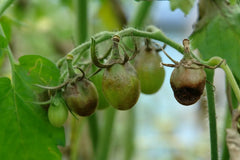
Phytophthora infestans: the reason for the potato famine. It will first display as light green spots on the leaves that swiftly turn black while a white fungus develops on the underside of the plant. Late blight can be airborne and is often a result of an infected tuber, transplant or seed. The fungus moves fast in cold, wet conditions, killing the full plant within 7-10 days.
Photo: Scot Nelson
Septoria leaf spot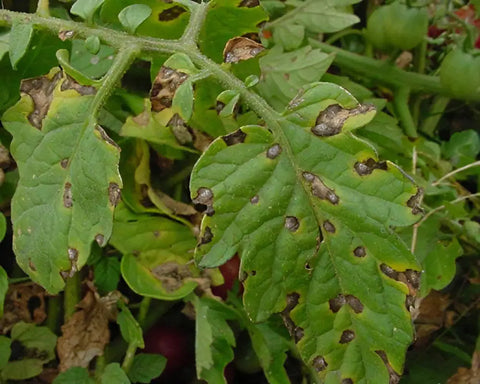
Begins at the base, affecting stems and the lowest leaves. Spots will be small and white with a dark border and, if left alone, will fully destroy the foliage.
Photo: Scot Nelson
Other troubles:
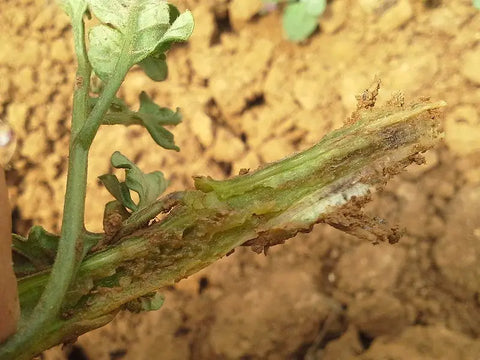 Fusarium Wilt
Fusarium Wilt
A soil borne fungus that gets into the roots and disrupts the water vessels in your plant, causing the leaves to wilt and turn yellow. It can spread through water, insects, contaminated soil or gardening tools.
Photo: Scot Nelson
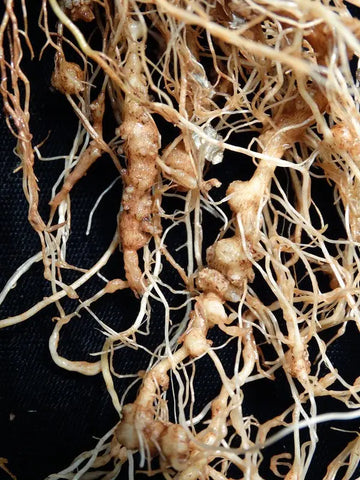 Nematodes
Nematodes
Tiny, microscopic worms that feed on fungi. Some are helpful, but the type that harm your tomato plants are known as Root-knot nematodes. They feast on the nutrients in your plant's roots leaving none for the foliage and fruit. Look for yellowing, wilting or stunting and any big knob-like growth (if you decide to peek at the roots).
Photo: Scot Nelson
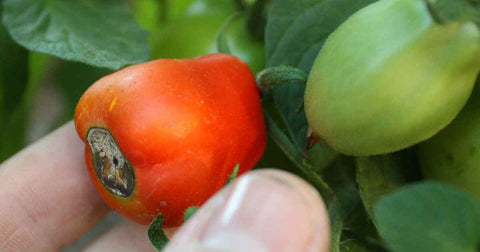 Blossom end rot
Blossom end rot
Occurs when there are insufficient levels of calcium in the plant. It's physiological (weather, conditions, etc) so it is more easily remedied. Your soil may contain plenty of calcium but if the plant is stressed, experiences periods of drought or is otherwise restricted in moisture, the calcium will not make it up to the tomato fruit causing decay around the blossoming end (bottom of the tomato). Knowing your soil’s pH levels will help: too high or too low a pH can lock up calcium and it will not be released to the plant. Poor calcium absorption can also be linked to damaged roots.
So, what to do?
The number one rule when signs of blight are found, is to destroy the entirety of the affected plant - don’t forget the roots! Pull it, burn it, or seal it in a bag and leave it in the sun to ensure it is destroyed. Do NOT compost the plant.
It’s important to not use any potentially contaminated soil so be sure to take careful measures when planting new tomatoes (or any nightshade) in previously used garden beds. Adding new organic matter, rotating in a resistant crop -like marigolds - or ‘solarizing’ your soil can help end the cycle and clear your earth of a fungal or nematode infection.
To ‘solarize’ - dampen and cover the affected area with clear plastic during the highest heat of the season. Leave it covered for 4 weeks, with the ends tucked deep into the earth - the sun will cook any weeds, pests, fungi and bacterial growth harmful to your plant.
For blossom end rot: remove the infected tomato. it does not spread from fruit to fruit so you may be able to produce healthy growth on the same plant provided you maintain a consistent moisture supply and check on your plants regularly.
Mulch is a major asset in promoting healthy tomato plants. It regulates moisture levels and prevents your soil from splashing back up onto your plant when watering.
Pruning will help too! Cutting off the lower leaves 12-18” above the soil level (any leaves that might come in contact with the soil) can prevent the soil splashing that keeps foliage too wet. Water tomatoes in the morning, focusing on the soil and not the full plant.
For your indeterminate varieties, pruning down to one or two vines and pinching out new growth (suckers) helps air circulation keeping your plant foliage healthy. Stake your determinate varieties: offering some vertical support and pruning a few leaves will help air move freely.
Fungicides work best as a preventative measure. Apply liberally to leaves, stems and flowers and don't forget your gloves. Keep an eye on your plants even after treatment. Fungi love humid environments, but they vary on temperature preference. Blights love the cold but Fusarium Wilt grows when the soil is hot.
Stressed plants are most susceptible to problematic growth so stay consistent with your garden; consider drip irrigation to maintain moisture levels and avoid oversaturating the foliage.
Tomatoes are gentle garden delights that require a little extra attention but oh so worth it come harvest time. When summer (finally) arrives and you’re sharing a bright garden salsa, caprese salad or crisp BLT with that fresh off the vine flavor, we promise you'll be glad you cared for them so tenderly 🍅


Pam – Yes, you can hand pollinate your plants just like Squash and Cucumbers. Wait for a dry sunny day when pollen will be most plentiful, and around midday, gently shake the stems of your flowers. Use a paintbrush to collect the pollen and directly apply it to the flower you’d like to pollinate. Reach out to us at hello@superseeds.com for more specific instructions if you’d like. Keep us posted!
Carol – I"m sorry to hear your plants are struggling. It seems the biggest issue we’ve faced this season is the high stress the plants are under with the extreme fluctuations – the long periods of high heat and no rain and then intense downpours for days on end. The consistency is hard to maintain when the weather is like this and tomato plants are finicky about their resources. Are you fertilizing your plants? It may help encourage a bit of fruiting before your season ends. We have some plants in containers to move when faced with extreme conditions: heavy rain OR high heat. Feel free to email us at hello@superseeds.com if you want to troubleshoot with some of our gardeners!
Our tomato “experts” warn us NOT to compost any tomato plants, whether they have blight or not. Tomato plants are
notorious for collecting all sorts of fungi, so it is a good idea to burn or dispose of “spent” plants. Keep them out of
compost bins !!!
My tomato plants look great. They have lots of flowers but NO tomatoes. I haven’t seen as many bees as we usually have. Is there someway I can
hand pollinate these plants?
My tomatoes have a different problem. The leaves curled earlier in June and have not recovered yet. They are only starting to bloom a little but no tomatoes. This is August. I don’t know how to add picture here. I thought it was because it was very dry then and tried to occasionally water them but since we have had plenty of rain. I don’t know what to do and growing season is soon over.